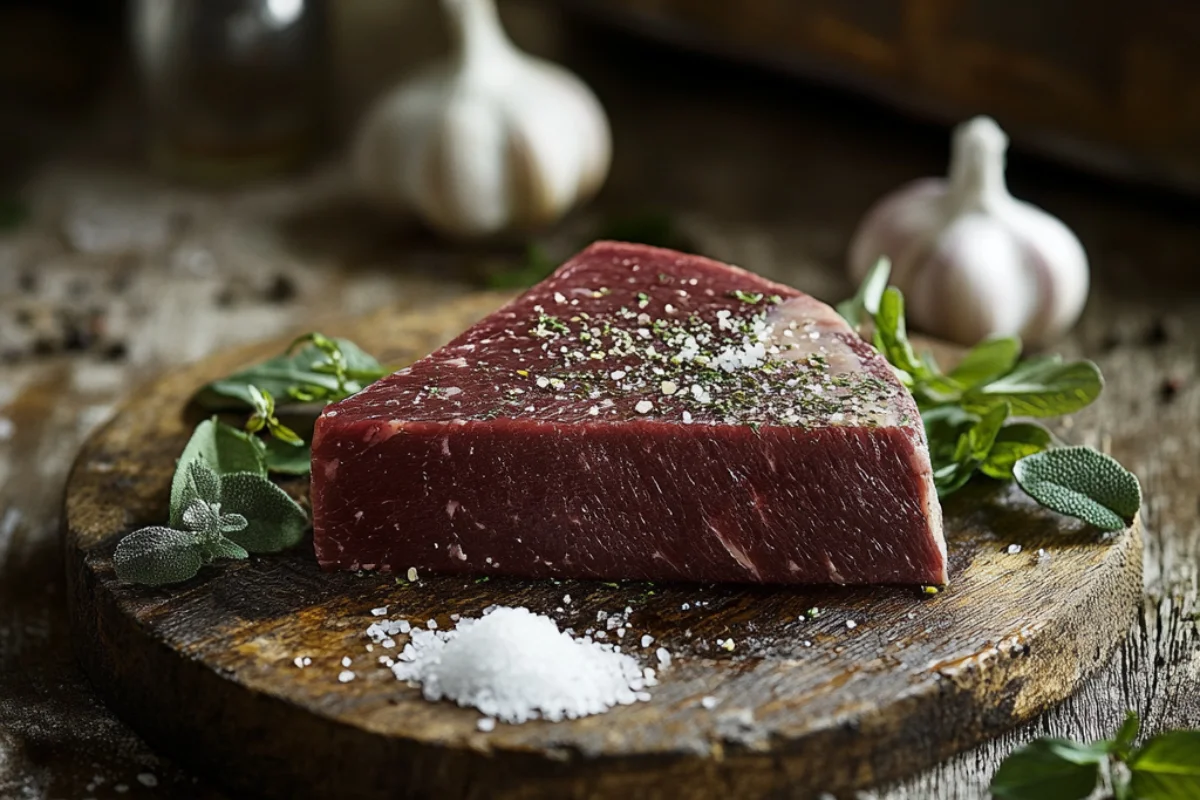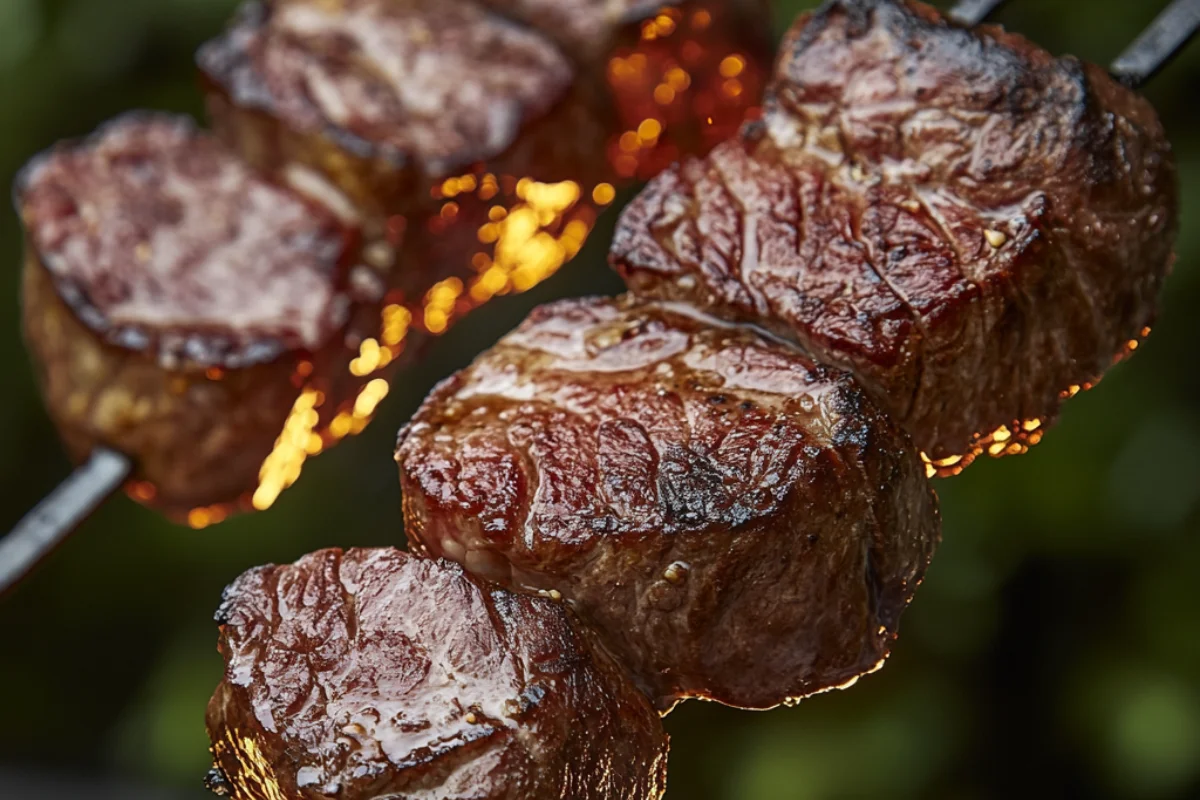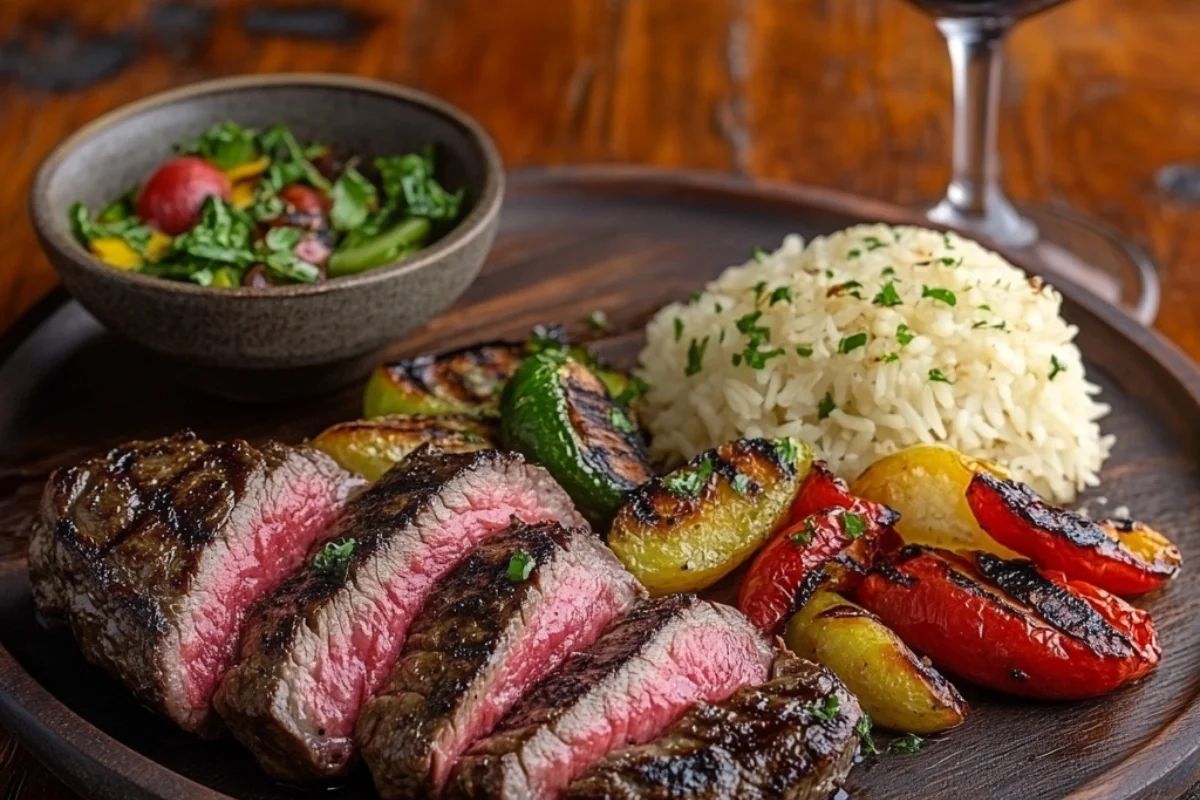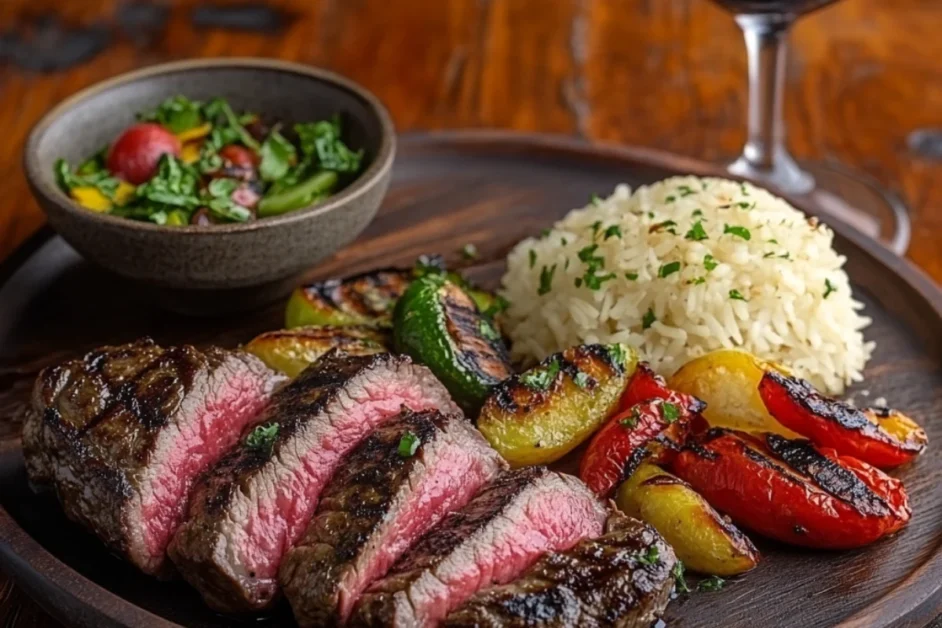Understanding Picanha and Its Fat Layer
What is Picanha?
Picanha fat cap is a highly prized cut of beef that originates from Brazilian cuisine, celebrated for its unique flavor profile and signature fat cap. Known globally for its tender texture and robust taste, Picanha has become a symbol of Brazilian churrasco (barbecue). But what exactly sets it apart from other cuts of meat? Let’s explore its origins, characteristics, and the role of its iconic fat layer.
The Origin of Picanha in Brazilian Cuisine
Picanha holds a special place in Brazilian culinary traditions. This cut comes from the rump cap, also referred to as the sirloin cap or culotte in other parts of the world. In Brazil, however, butchering practices emphasize retaining the fat cap, which enhances the meat’s flavor and juiciness when grilled.
Brazilian barbecue, or churrasco, celebrates Picanha as one of its main attractions. Traditionally skewered and roasted over open flames, it is often seasoned simply with rock salt, allowing the natural flavors to shine. Picanha’s rise to prominence in Brazil reflects the country’s love for high-quality beef and techniques that maximize flavor.
Key Characteristics of Picanha

Picanha is renowned for several defining characteristics:
- Shape and Size: A triangular cut, typically weighing 2-3 pounds, making it easy to handle on a grill.
- Marbling: While not heavily marbled like a ribeye, Picanha boasts a distinct fat layer.
- Tenderness: When cooked correctly, it offers a tender bite and buttery texture.
- Fat Cap: This thick, white layer of fat is the defining feature of Picanha, contributing to its distinct taste and succulence.
The Signature Fat Cap: What Makes It Unique
The fat cap is not just a visual trademark; it’s the secret behind Picanha’s flavor and texture. When grilled, this layer melts, basting the meat with rich, buttery juices. This process ensures the beef stays moist and tender, even over high heat.
The fat cap also caramelizes beautifully, creating a crispy outer crust. This contrast between the crispy exterior and juicy interior makes Picanha an unforgettable dining experience.
Picanha’s Place in Global Culinary Traditions
While Picanha is most celebrated in Brazil, it has made its way into other culinary traditions around the world. In the United States, Picanha is gaining recognition in steakhouses and home grilling enthusiasts. In Europe, particularly in Portugal, it is also a beloved cut. However, it’s often misidentified as part of the sirloin in many countries due to different butchering practices.
As Picanha becomes more globally recognized, chefs and home cooks alike are appreciating the importance of the fat cap and how it sets this cut apart from more familiar options like ribeye or tenderloin.
The Role of Fat in Picanha
Fat is a critical element in the appeal of Picanha. From its flavor-enhancing properties to its impact on texture, the fat cap is what makes this cut shine in comparison to others. But why is the fat layer so important, and what role does it play in making Picanha exceptional?
Why Picanha Has a Fat Cap
The fat cap on Picanha is integral to its preparation and flavor. Unlike other cuts that rely on internal marbling, Picanha’s fat layer sits on top, serving as a built-in basting agent.
When cooked, the fat cap melts, infusing the meat with moisture and flavor. This renders the fat into a rich, buttery essence that enhances every bite. Without this cap, Picanha would lose much of its signature taste and succulence.
The Function of Fat in Flavor and Texture
Fat plays two essential roles in Picanha:
- Flavor Enhancement: As the fat melts, it releases aromatic compounds that enhance the beef’s natural umami flavors. The result is a rich, beefy taste that is hard to replicate with leaner cuts.
- Texture Optimization: Fat creates a barrier that helps the meat retain moisture during cooking. It also adds a tender, juicy quality to the beef, even when cooked to medium or well-done.
Comparing Picanha Fat with Other Cuts of Meat
The fat cap on Picanha is distinct from the marbling found in cuts like ribeye or wagyu. While marbling refers to intramuscular fat, Picanha’s fat cap is external, creating a different cooking dynamic.
- Ribeye: Marbling provides a uniform distribution of fat, creating a rich flavor throughout the meat.
- Tenderloin: Extremely lean, with little to no fat, resulting in a milder flavor and a softer, less fatty texture.
- Picanha: The external fat cap creates a crisp outer layer while the meat underneath remains tender and juicy.
The Importance of Marbling vs. Fat Cap
When comparing marbling and the fat cap, each serves different purposes. Marbling enhances flavor throughout the meat, while the fat cap acts as an external flavor source that also protects the meat during cooking.
For Picanha, the fat cap is a non-negotiable feature. It delivers the bold, juicy flavor that distinguishes this cut from other steaks. Without it, the essence of Picanha is lost.
Picanha vs. Other Cuts: The Role of Fat
To truly appreciate Picanha, it’s helpful to compare it to other popular cuts of meat. The fat cap is the most defining difference, and it’s what makes Picanha unique in both flavor and preparation.
Differences Between Picanha and Sirloin or Ribeye
While Picanha is technically part of the sirloin, it offers a different experience.
- Picanha vs. Sirloin: Sirloin is a leaner cut, often lacking the external fat cap. This makes it less rich and juicy compared to Picanha.
- Picanha vs. Ribeye: Ribeye has abundant marbling but lacks the thick fat cap that defines Picanha. The result is a different texture and flavor profile.
In essence, Picanha offers the best of both worlds: the tenderness of a well-marbled cut and the flavor-enhancing properties of an external fat cap.
How the Fat Cap Sets Picanha Apart
The fat cap is what elevates Picanha above other cuts. It’s not just a feature—it’s the soul of this steak.
- Grilling Performance: The fat cap protects the meat during high-heat grilling, preventing it from drying out.
- Flavor Development: As the fat renders, it bastes the meat, imparting a buttery richness that few other cuts can achieve.
- Aesthetic Appeal: The caramelized fat crust is a visual and textural delight, creating a dining experience that’s as appealing to the eyes as it is to the palate.
To Eat or Not to Eat: The Debate on Picanha Fat
The fat cap on Picanha is as divisive as it is iconic. For some, it’s a delicious highlight of the cut, adding flavor and richness. For others, it’s a component best avoided due to texture or dietary concerns. Let’s dive into the cultural, scientific, and culinary aspects of this debate.
Should You Eat the Fat on Picanha?
Picanha’s fat cap isn’t just a visual hallmark—it’s a key contributor to the steak’s flavor and texture. Whether you should eat it, however, depends on personal preferences, cultural influences, and health considerations.
Cultural Practices and Preferences Around Picanha Fat
In Brazilian churrasco culture, eating the fat cap is part of the experience. The fat is considered integral to enjoying Picanha, and leaving it uneaten might even be seen as wasteful.
- Brazil: The fat is grilled to perfection, creating a crispy crust that diners savor. Eating the fat is often viewed as a culinary tradition.
- United States: Preferences vary widely. While many enjoy the rendered fat, others trim it off for a leaner bite.
- Europe: In countries like Portugal, where Picanha is popular, the fat is typically cooked but not always eaten.
Cultural practices highlight the subjectivity of taste. What’s prized in one cuisine might be avoided in another.
How Fat Enhances the Eating Experience
The fat cap isn’t just for looks—it transforms the dining experience by:
- Adding Flavor: Fat is a natural flavor enhancer, releasing buttery and beefy notes as it melts.
- Improving Texture: The rendered fat creates a juicy, succulent bite. When cooked properly, it becomes crispy on the outside while retaining a creamy interior.
- Balancing the Meat: The richness of the fat balances the leaner, beefier flavors of the meat beneath it.
Arguments for Eating the Fat
- Flavor: Fat enhances the overall taste, creating a richer, more indulgent flavor profile.
- Traditional Appeal: For those following traditional Brazilian barbecue techniques, eating the fat honors the authentic experience.
- Texture Contrast: The combination of crispy fat and tender meat adds a unique textural element.
Arguments Against Eating the Fat
- Health Concerns: Some people avoid animal fat due to its high calorie and saturated fat content.
- Texture Preferences: Not everyone enjoys the mouthfeel of rendered fat, which can be too rich or chewy for some.
- Dietary Choices: Leaner meat is often preferred by individuals aiming to reduce fat intake.
Ultimately, whether to eat the fat cap is a personal choice influenced by taste and dietary goals.
The Science of Eating Picanha Fat
Beyond personal preferences, there’s a scientific side to the fat debate. Understanding the nutritional value and health considerations of Picanha’s fat cap can help diners make informed choices.
Health Considerations of Consuming Animal Fat
Animal fat, including Picanha’s fat cap, is rich in saturated fat. While moderate consumption can be part of a balanced diet, excessive intake may contribute to health risks such as:
- Increased Cholesterol: High levels of saturated fat can elevate LDL cholesterol levels, potentially increasing the risk of heart disease.
- Caloric Density: Fat is calorie-dense, which can contribute to weight gain if consumed in excess.
That said, not all fats are created equal. Picanha fat also contains monounsaturated fats, which are considered healthier and can improve cholesterol profiles.
Nutritional Value of Picanha’s Fat Cap
Picanha’s fat cap isn’t just a source of calories—it also contains essential nutrients:
- Fat-Soluble Vitamins: Vitamins A, D, E, and K are often present in animal fat.
- Energy Source: Fat provides a concentrated source of energy.
- Flavor Molecules: The fat is rich in compounds that enhance the taste of the meat.
Moderation and Balanced Consumption
The key to enjoying Picanha fat lies in moderation. A small amount of fat can provide flavor and nutrients without significantly impacting your diet. Pairing Picanha with lighter side dishes, such as vegetables or salads, can help balance the meal.
Cooking Methods and Their Impact on the Fat Cap
Cooking methods play a critical role in determining the texture and flavor of Picanha’s fat. Whether you grill, broil, or pan-sear the meat, the technique can influence how much of the fat is rendered and how crispy the exterior becomes.
Grilling Techniques to Render the Fat

Grilling is the most traditional way to prepare Picanha, especially in Brazilian churrasco. When done correctly, grilling renders the fat cap perfectly.
- Direct Heat: Placing the fat cap directly over the flame allows it to render and caramelize, creating a crispy crust.
- Slow Cooking: By cooking over indirect heat first, the fat renders slowly, ensuring it doesn’t burn before the meat is done.
Grilling highlights the natural flavors of the fat, making it an essential part of the Picanha experience.
Broiling vs. Pan-Searing: The Effect on the Fat Layer
Other cooking methods can also impact the fat layer:
- Broiling: High, direct heat from the broiler crisps the fat but may not fully render it. This method works well for those who enjoy a slightly firmer fat texture.
- Pan-Searing: Searing Picanha in a hot skillet allows the fat to render into the pan. The rendered fat can then be used to baste the meat, intensifying its flavor.
Each method offers unique benefits, but grilling remains the gold standard for achieving the perfect balance of crispy and rendered fat.
How Cooking Affects Flavor and Texture of the Fat
The cooking process transforms the fat layer in several ways:
- Caramelization: Heat causes the fat’s exterior to caramelize, adding a slightly sweet, crispy texture.
- Rendering: The internal fat melts, infusing the meat with flavor while reducing the thickness of the fat cap.
- Aromatics: As the fat cooks, it releases aroma compounds that enhance the overall flavor of the dish.
Cooking techniques significantly influence whether the fat is enjoyable or overwhelming. A perfectly cooked fat cap is crisp, flavorful, and complements the meat rather than overpowering it.
Tips, Tricks, and Regional Variations
Picanha is a steak unlike any other, celebrated for its signature fat cap and exceptional flavor. To fully enjoy this cut, understanding how to cook, serve, and pair it with complementary dishes and beverages is essential. Here are expert tips and insights into how Picanha is enjoyed worldwide.
Expert Tips for Enjoying Picanha
From preparation to serving, maximizing the experience of Picanha comes down to the details.
How to Cook Picanha to Perfection
Cooking Picanha is both an art and a science. The key lies in managing the fat cap and ensuring the meat cooks evenly. Here are some expert tips:
- Trim with Care: Avoid removing too much of the fat cap—this layer is essential for keeping the meat juicy. Trim only excess or overly thick portions for balanced rendering.
- Season Simply: Let the natural flavors of the beef shine. Use coarse salt and, optionally, black pepper or garlic.
- Cook Over High Heat: For grilling, start with the fat side down over high heat to render and caramelize the fat. Then, move to indirect heat to finish cooking.
- Reverse Sear: For oven or skillet preparation, cook the Picanha slowly at a lower temperature, then sear at high heat to create a crust.
- Monitor Doneness: Aim for medium-rare to medium (125–135°F) for optimal tenderness and flavor. Overcooking can dry out the meat.
Slicing Techniques to Balance Fat and Meat
Slicing Picanha properly ensures a perfect balance of fat and lean meat in every bite.
- Against the Grain: Always slice against the grain to maintain tenderness.
- Keep the Fat Intact: When carving, include a portion of the fat cap with each slice. This creates the ideal flavor and texture combination.
- Angle for Presentation: Slice at a slight angle to showcase the layers of meat and fat for an aesthetically pleasing presentation.
Regional Variations in Eating Picanha
While Picanha is most famously associated with Brazilian churrasco, its preparation and consumption vary across regions.
Brazilian Traditions and Customs
In Brazil, Picanha is the centerpiece of any barbecue. The traditions emphasize simplicity and communal enjoyment.
- Churrasco-Style Preparation: Picanha is skewered in thick cuts and grilled over open flames, seasoned with only coarse salt.
- Serving Method: Meat is sliced directly from the skewer at the table, ensuring it’s fresh, hot, and tender.
- Fat Appreciation: The crispy, rendered fat is a delicacy and considered a must-eat component.
How Picanha is Served in Other Countries
Picanha’s global popularity has led to unique adaptations:
- United States: Often cooked as a whole roast or portioned into individual steaks. It’s frequently served with chimichurri or other sauces.
- Portugal: Known as “posta,” Picanha is typically roasted or grilled and served with rice and potatoes.
- Argentina: While not as iconic as other cuts, Picanha is gaining popularity in asados (Argentine barbecues) and is often paired with Malbec wine.
These regional variations highlight how Picanha can adapt to different culinary traditions while retaining its essential appeal.
Pairing Picanha with Side Dishes and Beverages

A well-prepared Picanha deserves equally thoughtful pairings. The richness of the fat cap calls for sides and drinks that balance its intensity while enhancing its flavors.
Complementary Side Dishes for Picanha Fat
The ideal side dishes for Picanha offer contrasting textures and flavors to complement the succulent fat:
- Vinaigrette Salad: A Brazilian favorite, this tangy mix of tomatoes, onions, and vinegar cuts through the richness of the meat.
- Garlic Rice: The simplicity of rice seasoned with garlic provides a neutral, comforting base.
- Grilled Vegetables: Asparagus, bell peppers, or zucchini add a smoky, fresh element to the meal.
- Farofa: Toasted cassava flour mixed with butter, onions, and bacon adds a nutty, crunchy texture to balance the softness of the meat.
- Potato Dishes: Roasted or mashed potatoes absorb the rendered fat, creating a hearty and indulgent side.
Beverages That Balance the Richness of Fat
Pairing the right drink with Picanha enhances the overall dining experience. The goal is to balance the fat with acidity, tannins, or effervescence.
- Red Wine: Full-bodied wines like Malbec, Cabernet Sauvignon, or Syrah complement the richness of the meat.
- Caipirinha: Brazil’s national cocktail, made with cachaça, lime, and sugar, provides a refreshing citrus contrast.
- Beer: A crisp lager or pale ale cleanses the palate between bites.
- Sparkling Water: For a non-alcoholic option, sparkling water with a twist of lemon is a great palate cleanser.
Final Thoughts on Eating Picanha Fat
At the end of the day, the decision to eat the fat on Picanha comes down to personal preference and how it fits into your culinary style and dietary goals.
Embracing Personal Preference
Not everyone will enjoy the fat cap, and that’s perfectly fine. The beauty of Picanha lies in its versatility. Whether you savor the fat or prefer the leaner parts of the cut, Picanha offers something for everyone.
- For traditionalists, the fat cap is a defining feature that should be celebrated.
- For those seeking a lighter meal, trimming some fat while cooking can still deliver a flavorful experience.
Guidelines for an Enjoyable Experience
- Start Small: If you’re unsure about eating the fat, begin with a small portion to see how you like it.
- Experiment with Cooking: Try different methods (grilling, pan-searing, or roasting) to see how the fat transforms.
- Balance Your Plate: Pair Picanha with sides and drinks that complement and balance its richness.
- Enjoy the Moment: Picanha is more than just a cut of meat—it’s an experience rooted in tradition and sharing.
Whether you’re a Picanha purist or a first-timer, exploring the fat cap adds depth to the culinary journey, making it as satisfying as it is flavorful.
FAQs: Understanding Picanha and Its Fat Layer
1. What is Picanha?
Picanha is a beef cut popular in Brazilian cuisine, taken from the top of the rump. It is celebrated for its signature fat cap, which enhances flavor and juiciness during cooking.
2. Why does Picanha have a fat cap?
The fat cap on Picanha serves as a natural basting layer, keeping the meat moist and infusing it with a buttery, rich flavor as it renders during cooking.
3. Should I eat the fat on Picanha?
Eating the fat is a matter of personal preference. In Brazilian traditions, the fat is considered a delicacy. If you enjoy rich, savory flavors, the fat can be a delightful addition to the meal.
4. Is Picanha the same as sirloin?
Picanha comes from the top of the rump and is technically part of the sirloin. However, it is distinct due to the thick fat cap, which is often trimmed off in other sirloin cuts outside of Brazil.
5. What’s the best way to cook Picanha?
Grilling is the most traditional method, especially in Brazilian churrasco. Start by cooking the fat side down over high heat to render the fat, then finish on indirect heat for even cooking.
6. What makes Picanha different from ribeye or tenderloin?
Picanha is unique because of its external fat cap, whereas ribeye relies on internal marbling, and tenderloin is lean with little fat. Picanha offers a balance of tenderness and bold flavor.
7. Is Picanha fat healthy to eat?
Picanha fat is high in saturated fat, which should be consumed in moderation. However, it also contains monounsaturated fats and fat-soluble vitamins, making it a flavorful and nutrient-rich addition when eaten occasionally.
8. How should Picanha be sliced?
Always slice Picanha against the grain to maintain tenderness. Include a portion of the fat cap in each slice for the perfect balance of flavor and texture.
9. What are the best sides to serve with Picanha?
Complement Picanha with sides that balance its richness, such as vinaigrette salad, garlic rice, grilled vegetables, or farofa (toasted cassava flour). These dishes add freshness and texture to the meal.
10. What drinks pair well with Picanha?
Bold red wines like Malbec or Cabernet Sauvignon, citrusy cocktails like Caipirinha, or crisp lagers are ideal pairings. Non-alcoholic options include sparkling water with lemon to cleanse the palate.

